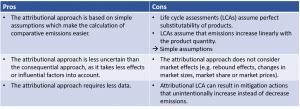As customer awareness for sustainability-related issues is on the rise, companies are increasingly interested in claiming that their products can help avoid greenhouse gas emissions in comparison to other products on the market. We explain what avoided emissions are and how they can be estimated.
The World Resources Institute (WRI) has recently published a paper about estimating and disclosing both positive and negative impacts of products, goods or services. If one product’s life cycle requires less emissions than another product, we speak of so-called “avoided emissions”. Wouldn’t it be advantageous to credibly disclose that your product emits less than your competitor’s product? For this purpose, the World Resources Institute presents a neutral framework to consistently disclose comparative emissions.
What is the benefit of disclosing avoided emissions?
- By considering both positive and negative impacts, companies improve their credibility and gain their customer’s trust.
- Companies have an incentive to develop and promote low-carbon products.
What are the key prerequisites for reporting avoided emissions?
- Companies should first calculate and report scope 1, 2 and 3 emissions and set science-based reduction targets for these emissions.
- Companies should not make claims about having avoided emissions without being transparent about whether their scope 1, 2, and 3 emissions are increasing or decreasing.
- Accounting and reporting of emissions should adhere to the following criteria:
Relevance, Completeness, Consistency and Transparency.
How are comparative product GHG impacts estimated?
An assessed product’s avoided emissions can be estimated using either attributional or consequential accounting approaches.
Attributional Approach: Attributional approaches generate inventories of a product’s absolute emissions through a life-cycle analysis. Life-cycle analyses enable the identification and relation of all inputs and outputs of the entire product system. If the comparative GHG impact is positive, the assessed product has avoided emissions over its life cycle compared to the reference product.

Attributional Approach
Consequential Approach: Consequential methods estimate the system-wide change in emissions that results from a given decision, e.g. a new government policy. This approach considers influential factors such as market effects, extra-boundary effects as well as policy and nonpolicy drivers. For this reason, the WRI recommends implementing consequential accounting whenever applicable.

Consequential Approach
DFGE can support you in calculating and analyzing your Carbon Footprint (including Scope 1, 2 and 3 emissions). DFGE can also help you disclose your avoided emissions through the use of your product. This will help you to gain valuable insights into the potentials of your future climate strategy and to publicly illustrate how your product avoids emissions, compared to other products. Contact us via or via phone: +49 8192 99733 20 to learn more!









